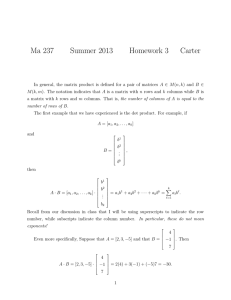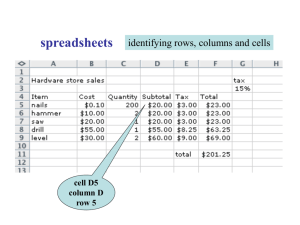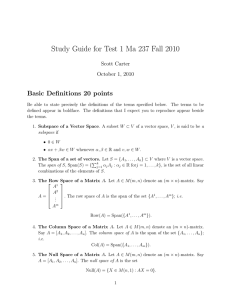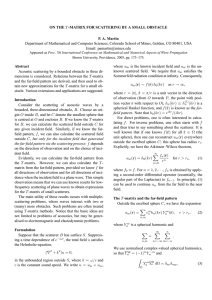Ma 237-101(CRN:30074) Summer 2015 HW 3 Carter
advertisement
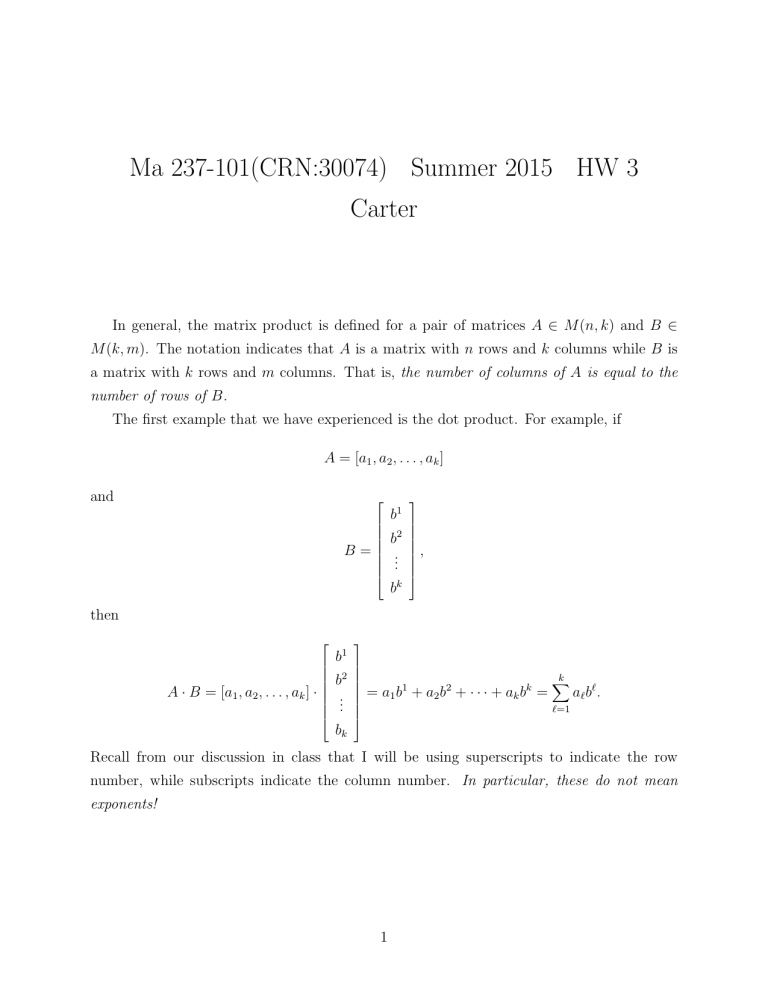
Ma 237-101(CRN:30074) Summer 2015 HW 3 Carter In general, the matrix product is defined for a pair of matrices A ∈ M (n, k) and B ∈ M (k, m). The notation indicates that A is a matrix with n rows and k columns while B is a matrix with k rows and m columns. That is, the number of columns of A is equal to the number of rows of B. The first example that we have experienced is the dot product. For example, if A = [a1 , a2 , . . . , ak ] and 1 b 2 b , B= .. . bk then 1 b 2 k b X A · B = [a1 , a2 , . . . , ak ] · . = a1 b1 + a2 b2 + · · · + ak bk = a` b ` . . . `=1 bk Recall from our discussion in class that I will be using superscripts to indicate the row number, while subscripts indicate the column number. In particular, these do not mean exponents! 1 4 Even more specifically, Suppose that A = [2, 3, −5] and that B = −1 . Then 7 4 −1 = 2(4) + 3(−1) + (−5)7 = −30. A · B = [2, 3, −5] · 7 In this preliminary numeric case, A is a (1 × 3)-matrix, and B is a (3 × 1)-matrix. In general if A is an (n × k)-matrix and B is a (k × m)-matrix, then the matrix product A · B is an (n × m)-matrix in which the (i, j)th entry is the dot product of the ith row of A with the jth column of B. If a`i is the entry in the ith row and `th column of the matrix A and bj` is the entry in the `th row and jth column of B, then the matrix entry in the ith row, jth column of the product is = a`i bj` . Usually, when we first see the formula, it Pk `=1 scares us, so let’s see an example. Let A = 1 2 −4 2 5 3 1 2 3 and let B = 2 4 6 . Then 3 6 9 A·B = = 3·1+1·2+2·3 3 1 2 −4 2 5 3·2+1·4+2·6 · 1 2 3 2 4 6 3 6 9 3·3+1·6+2·9 −4 · 1 + 2 · 2 + 5 · 3 −4 · 2 + 2 · 4 + 5 · 6 −4 · 3 + 2 · 6 + 5 · 9 Compute the matrix product of the following matrices. 1. 2. 3. 1/3 0 0 1 1/3 −4/3 0 1 1/2 0 0 1 2 · · · 1 −4 0 1 3 4 24 0 1 0 2 −5 0 1 = 11 22 33 15 30 45 . 4. 1 −5/2 0 1 1 −1 5. 1/5 0 1 −4/5 0 8. 9. 11. 13. · 1 0 1/4 0 1 0 0 0 1 0 0 1 0 1 1 0 1 1 −3 3 4 24 1 0 0 3 4 8 24 0 1 0 0 3 4 8 24 · 0 1 0 0 0 1 1 0 −1 · 0 1 −2 1 0 0 0 1 0 0 3 0 0 1 0 · · 0 5 −4 20 1 1 5 −4 1 1/3 −4/3 −8/3 0 1 0 · 1/4 −3/4 0 0 0 1 1 1 · −3 1 0 0 1/3 −4/3 12. 1 1 · 1 0 1 · 1 0 2 −5 30 0 10. · 6. 7. 0 1 0 0 14. 15. 16. 17. 1 0 −1 0 1 1 0 −1 · −2 1 0 0 0 1 0 0 1 0 0 · −2 0 0 0 1 0 0 0 1 0 1 1 0 · 0 0 0 1 −1 −2 1 0 0 1 0 1 1 0 2 −1 −2 1 −1 0 1 0 −1 1 1 0 −1 1 0 1 1 1 1 · 2 0 1 4 0 0 1 1 2 0 18. Solve the system of equations x + y + z = 1 2x + z = 4 y + z = 2 Can you relate your solution to the previous several computations? 4
